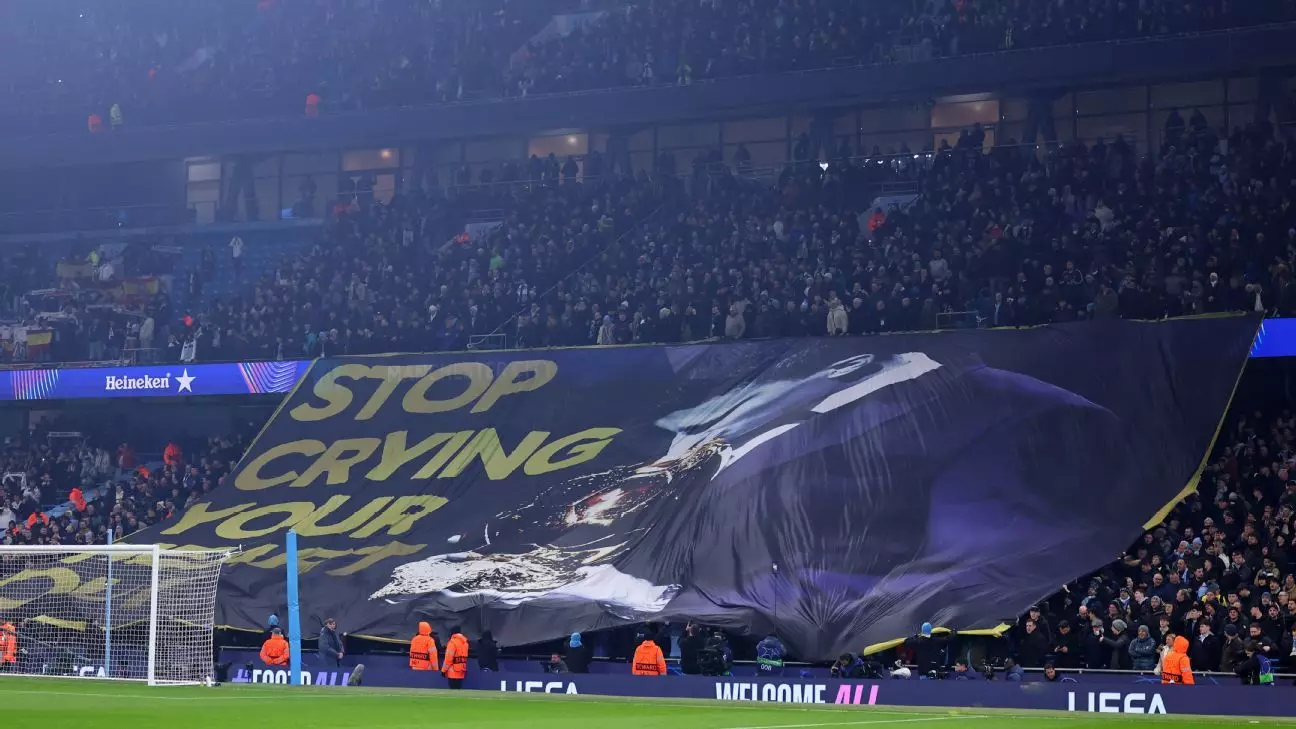Football, an arena of passion and fierce competition, extends beyond the pitch to the fervent displays of fan culture. One of the most vibrant elements of this culture is the tifo—elaborate displays crafted by supporters that often convey messages that can ignite pride, provoke rivalry, or even serve as psychological warfare against opponents. These visual spectacles encapsulate the spirit of football fandom and often reflect the history, emotion, and rivalry of the clubs involved. A recent encounter between Manchester City and Real Madrid in the UEFA Champions League illustrates just how impactful these gestures can be, not just for the players on the field, but for fan engagement and psychological gamesmanship.
The Fallibility of Hubris
The encounter at the Etihad Stadium saw Manchester City suffer a stinging 3-2 defeat, an outcome that not only hurt their Champions League hopes but also starkly contrasted with the bravado shown by their supporters prior to the match. City fans unfurled a striking banner aimed squarely at Real Madrid, mocking their excessive lament over star Vinícius Júnior’s failure to secure the 2024 Ballon d’Or. This display, featuring Rodri amidst the cheeky message “Stop crying your heart out,” attempted to undercut Madrid’s complaints surrounding the awards ceremony, illustrating the thin line between pride and folly in fan displays.
In a twist of irony, the very team that was ridiculed emerged victorious. Real Madrid’s response was swift and effective, clinching victory with a late comeback, leaving City fans to ponder the consequences of their taunts. When the stakes are this high in football, such displays can quickly turn from celebrations of superiority to sources of embarrassment.
The psychological impact of tifos is nuanced; what is meant as a derisive jab can often stoke the fires of competition within players. Vinícius Júnior himself acknowledged the emotional weight the banner carried for him, admitting that it intensified his desire to perform. His standout performance, crowned with the Player of the Match title, served as a direct counter to the earlier taunts, illustrating how fan displays can inadvertently rally opponents rather than demoralize them.
A key takeaway from this incident is that, while fans wish to assert dominance over rivals through these artful expressions, the outcomes are unpredictable. What seems like clever banter can morph into an invigorating challenge for the players as they seek redemption on the field.
A Tradition of Tifo Wars
The history of football is littered with similar back-and-forths between fan bases, showcasing the blend of creativity and rivalry. Classic examples abound—Madrid’s own ultras have been known to flaunt their historic wins in direct confrontations with local rivals, Atletico Madrid, reminding them of past defeats through elaborate displays. Such episodes highlight a culture steeped in rivalry where fans use artistic expression as a vehicle to assert dominance over their adversaries.
Another noteworthy rivalry between Paris Saint-Germain and AC Milan further illustrates this phenomenon. Their encounters have been marked by tit-for-tat tifos that not only mock the other but serve as a representation of their unique cultures, histories, and inter-club dynamics. Each tifo serves as a reminder of the stakes involved in these encounters, where not just three points are at play, but local pride and global prestige.
While the creativity behind tifos can lead to memorable moments, some displays tread precariously close to distastefulness. The Montreal Impact’s audacious jab at the culinary culture of the United States stands as an example of how fan displays can transcend football and incite social commentary—albeit humorously. Their message ‘”Your maple syrup is weak”‘ not only drew laughter but also demonstrated the impact tifos can have beyond the footballing world.
Such displays invite scrutiny; while some are embraced as clever or humorous, others may warrant backlash. The fine line between good-natured rivalry and offensive mockery can lead to escalating tensions that impact the atmosphere of matches and the overall integrity of the sport.
In the electrifying world of football, tifos have earned their place as powerful instruments of expression, capable of motivating teams or deriding rivals. However, as demonstrated by Manchester City’s folly and Madrid’s resurgence, these strategies can backfire spectacularly. Fans must navigate the intricate tapestry of rivalry with care, for while a tifo can bolster camaraderie and pride within their own ranks, it can equally provide fuel for their opponents if miscalculated. As football continues to evolve, the art of creating impactful tifos will remain a dynamic interplay between inspiration and rivalry, forever etched in the annals of the game.

Leave a Reply